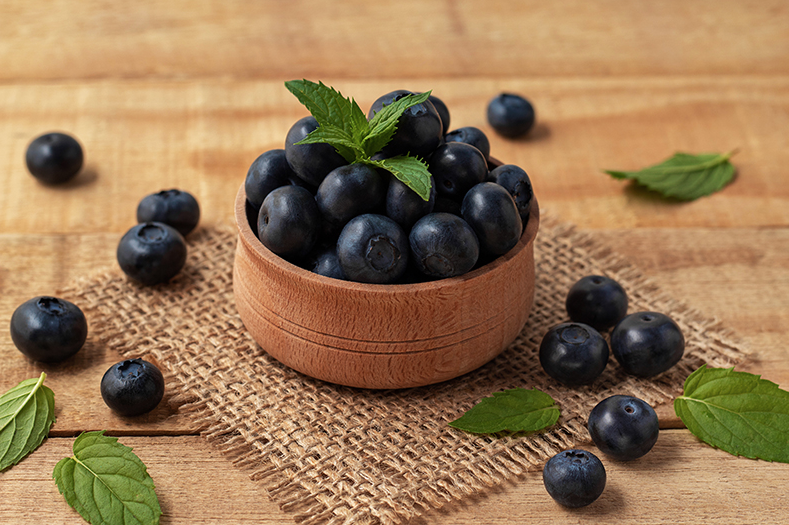
Bilberry
Bilberry dark berries resemble blueberries, and it’s powerful antioxidant. It’s also known by the name “European blueberries”.
Usage
Among other things, they are beneficial as prevention or therapy for avitaminosis or hypovitaminosis, as well as for the treatment of non-infectious diarrhea in children.
Antioxidants
Help fight free radicals in body and protect against damage and disease.
Good for eyes
Bilberry can support eye health.
Blood sugar levels
They popular herbal remedy used to lower blood sugar levels in people with type 2 diabetes.

How to add bilberries to your diet?
Their dietary effect is very important. They are tasty in everything from jams, muffins to cheesecakes.
Fresh or Juice
The fruits are best used fresh or as juice. They have a much more tart flavor than blueberries,
Syrups, jams
They can be used to make delicious and quality syrups, jams, compotes, etc. only vitamin C is lost during cooking.
Baking
They have a more intense, fruity, sweet, and tangy flavor then blueberries and can be used when baking.
Each berry is a single fruit, they are not aggregate like the cultivated berries.
The name bilberry has a Scandinavian origin, from the 16th century.
The bilberry is also known as blaebery in Scottish and Northern English regional dialects.
In south Wales and England they have been in traditional use for cooking and home remedies.
Ancient Herbal Therapy
Historically, bilberry has been used across Europe for a variety of conditions, including diarrhea, inflammation of the mouth, urinary problems, and diabetes. High vitamin C content made them suitable for scurvy prevention.
Greeks used them to treat diarrhea and other digestive-related issues. In the 16th century, bilberries were reportedly used in the treatment of hemorrhoids, vaginal discharges, coughs, lung tuberculosis, and urinary complaints.
About
Bilberry is a common name for multiple members of the genus Vaccinium. These plants are shrubs, up to 50 cm tall with thick and thin twigs and green, shiny bark. The rim of the leaf is finely serrated, and the leaf stalks are very short. The fruit is a shiny berry of blue-black color and slightly sour taste, which ripens from July to September.
It contains a large number of seeds. Suitable soil for growth is acidic and moderately moist soil and they are present in the high altitudes, in the zone of deciduous, beech forests, and above it on fresh soils. Their role is significant in mountain clearings and subalpine acidophilic communities where large areas are overgrown. Some of them are frequent inhabitants of many mountains.
Science
The leaves have cardiotonic, diuretic, choleric, and astringent effects.
They are used as an ingredient in herbal mixtures for the treatment of grade II diabetes as well as in disorders of the digestive tract. With long-term use of leaves or if an overdose occurs, chronic poisoning is possible so self-medication is not recommended. Berries are, in general, one of the best dietary sources of antioxidants. Bilberries are an excellent source of anthocyanins, a potent group of antioxidants.
Safety
Bilberries are considered practically devoid of side effects. Fruit consumption is very safe, and no serious health threats have been reported. Although no medication interactions are known to occur with bilberry, theoretically, very high doses could potentially interact with some chronic disease medication, so bilberries should be used cautiously.
Preliminary evidence suggests that bilberry leaves might lower blood glucose, so diabetes drugs might require dosing adjustment. Typical dosage varies depending on the way of consumption, age, overall health, etc. People with previous allergic reactions to berries should avoid them completely.
Fun Facts
Pilots reported the use of bilberries in WW2 to sharpen their night vision for missions in the dark.
Sources
Ulbricht, C., Basch, E., Basch, S., Bent, S., Boon, H., Burke, D., ... & Woods, J. (2009). An evidence-based systematic review of bilberry (Vaccinium myrtillus) by the natural standard research collaboration. Journal of dietary supplements, 6(2), 162-200.
Helmstädter, A., & Schuster, N. (2010). Vaccinium myrtillus as an antidiabetic medicinal plant–research through the ages. Die Pharmazie-An International Journal of Pharmaceutical Sciences, 65(5), 315-321.
Wang, K., Liu, M., Cui, F., & Asiegbu, F. (2021). A simple phenol-free isolation method for high-quality RNA from bilberry. MethodsX, 101481.
